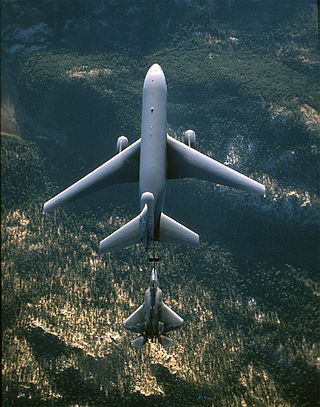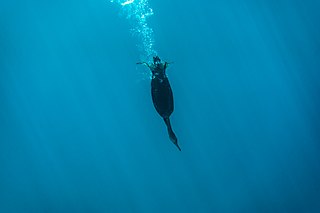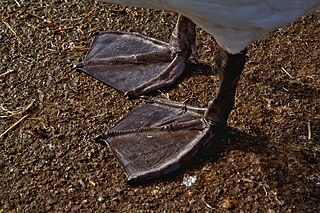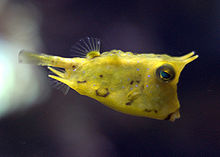
A fin is a thin component or appendage attached to a larger body or structure. Fins typically function as foils that produce lift or thrust, or provide the ability to steer or stabilize motion while traveling in water, air, or other fluids. Fins are also used to increase surface areas for heat transfer purposes, or simply as ornamentation.

A wing is a type of fin that produces both lift and drag while moving through air. Wings are defined by two shape characteristics, an airfoil section and a planform. Wing efficiency is expressed as lift-to-drag ratio, which compares the benefit of lift with the air resistance of a given wing shape, as it flies. Aerodynamics is the study of wing performance in air.

Propulsion is the generation of force by any combination of pushing or pulling to modify the translational motion of an object, which is typically a rigid body but may also concern a fluid. The term is derived from two Latin words: pro, meaning before or forward; and pellere, meaning to drive. A propulsion system consists of a source of mechanical power, and a propulsor.

Flight or flying is the motion of an object through an atmosphere, or through the vacuum of outer space, without contacting any planetary surface. This can be achieved by generating aerodynamic lift associated with gliding or propulsive thrust, aerostatically using buoyancy, or by ballistic movement.

The Exocoetidae are a family of marine ray-finned fish in the order Beloniformes, known colloquially as flying fish or flying cod. About 64 species are grouped in seven genera. While they do not "fly" in the same way a bird does, flying fish can make powerful, self-propelled leaps out of the water where their long wing-like fins enable gliding for considerable distances above the water's surface. The main reason for this behavior is thought to be to escape from underwater predators, which include swordfish, mackerel, tuna, and marlin, among others, though their periods of flight expose them to attack by avian predators such as frigate birds.

A flipper is a broad, flattened limb adapted for aquatic locomotion. It refers to the fully webbed, swimming appendages of aquatic vertebrates that are not fish.

In ethology, animal locomotion is any of a variety of methods that animals use to move from one place to another. Some modes of locomotion are (initially) self-propelled, e.g., running, swimming, jumping, flying, hopping, soaring and gliding. There are also many animal species that depend on their environment for transportation, a type of mobility called passive locomotion, e.g., sailing, kiting (spiders), rolling or riding other animals (phoresis).

Fish locomotion is the various types of animal locomotion used by fish, principally by swimming. This is achieved in different groups of fish by a variety of mechanisms of propulsion, most often by wave-like lateral flexions of the fish's body and tail in the water, and in various specialised fish by motions of the fins. The major forms of locomotion in fish are:

Bird flight is the primary mode of locomotion used by most bird species in which birds take off and fly. Flight assists birds with feeding, breeding, avoiding predators, and migrating.

A number of animals are capable of aerial locomotion, either by powered flight or by gliding. This trait has appeared by evolution many times, without any single common ancestor. Flight has evolved at least four times in separate animals: insects, pterosaurs, birds, and bats. Gliding has evolved on many more occasions. Usually the development is to aid canopy animals in getting from tree to tree, although there are other possibilities. Gliding, in particular, has evolved among rainforest animals, especially in the rainforests in Asia where the trees are tall and widely spaced. Several species of aquatic animals, and a few amphibians and reptiles have also evolved this gliding flight ability, typically as a means of evading predators.

Shark anatomy differs from that of bony fish in a variety of ways. Variation observed within shark anatomy is a potential result of speciation and habitat variation.

Around 350 BCE, Aristotle and other philosophers of the time attempted to explain the aerodynamics of avian flight. Even after the discovery of the ancestral bird Archaeopteryx which lived over 150 million years ago, debates still persist regarding the evolution of flight. There are three leading hypotheses pertaining to avian flight: Pouncing Proavis model, Cursorial model, and Arboreal model.
Gliding flight is heavier-than-air flight without the use of thrust; the term volplaning also refers to this mode of flight in animals. It is employed by gliding animals and by aircraft such as gliders. This mode of flight involves flying a significant distance horizontally compared to its descent and therefore can be distinguished from a mostly straight downward descent like a round parachute.

Aquatic locomotion or swimming is biologically propelled motion through a liquid medium. The simplest propulsive systems are composed of cilia and flagella. Swimming has evolved a number of times in a range of organisms including arthropods, fish, molluscs, amphibians, reptiles, birds, and mammals.

Fin and flipper locomotion occurs mostly in aquatic locomotion, and rarely in terrestrial locomotion. From the three common states of matter — gas, liquid and solid, these appendages are adapted for liquids, mostly fresh or saltwater and used in locomotion, steering and balancing of the body. Locomotion is important in order to escape predators, acquire food, find mates and bury for shelter, nest or food. Aquatic locomotion consists of swimming, whereas terrestrial locomotion encompasses walking, 'crutching', jumping, digging as well as covering. Some animals such as sea turtles and mudskippers use these two environments for different purposes, for example using the land for nesting, and the sea to hunt for food.

Fins are moving appendages protruding from the body of fish that interact with water to generate thrust and help the fish swim. Apart from the tail or caudal fin, fish fins have no direct connection with the back bone and are supported only by muscles.

Various marine animals are capable of aerial locomotion, i.e., jumping out of the water and moving through air. Some possible reasons for this behavior are hunting, escaping from predators, and saving energy for swimming or breathing. Some of the jumping behaviors initiate gliding and taxiing in air, while some of them end up falling back to water.

A robot fish is a type of bionic robot that has the shape and locomotion of a living fish. Most robot fish are designed to emulate living fish which use body-caudal fin (BCF) propulsion, and can be divided into three categories: single joint (SJ), multi-joint (MJ) and smart material-based "soft-body" design.

The webbed foot is a specialized limb with interdigital membranes (webbings) that aids in aquatic locomotion, present in a variety of tetrapod vertebrates. This adaptation is primarily found in semiaquatic species, and has convergently evolved many times across vertebrate taxa.
Batoids are a superorder of cartilaginous fish consisting of skates, rays and other fish all characterized by dorsoventrally flattened bodies and large pectoral fins fused to the head. This distinctive morphology has resulted in several unique forms of locomotion. Most Batoids exhibit median paired fin swimming, utilizing their enlarged pectoral fins. Batoids that exhibit median paired fin swimming fall somewhere along a spectrum of swimming modes from mobuliform to rajiform based on the number of waves present on their fin at once. Of the four orders of Batoidae this holds truest for the Myliobatiformes (rays) and the Rajiformes (skates). The two other orders: Rhinopristiformes and Torpediniformes exhibit a greater degree of body caudal fin swimming.

























